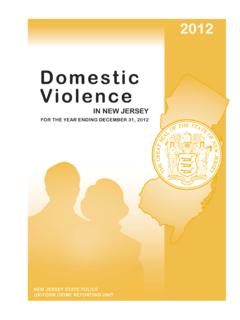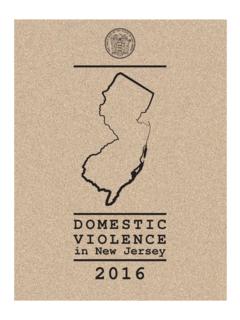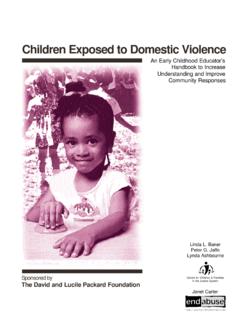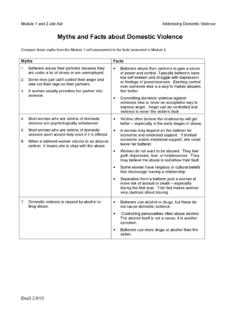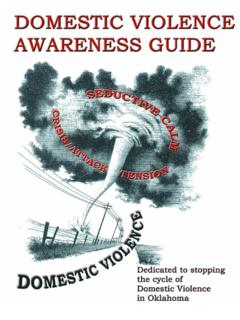Transcription of Behind Closed Doors The Impact of Domestic Violence on ...
1 11 STOP Violence IN THE HOMEB ehind Closed DoorsThe Impact of Domestic Violence on ChildrenThe children in this picture are supporting our campaign,and are not victims of Domestic do children need? We know the answer from our own and foremost, children need a safe and secure home, free of Violence ,and parents that love and protect them. They need to have a sense ofroutine and stability, so that when things go wrong in the outside world,home is a place of comfort, help and too many children , home is far from a safe haven. Every year, hundredsof millions of children are exposed to Domestic Violence at home, and thishas a powerful and profound Impact on their lives and hopes for children not only watch one parent violently assaultinganother, they often hear the distressing sounds of Violence , or may beaware of it from many telltale signs.
2 Me and my sister are scared, says one nine-year-old girl who lives in aviolent home in the United Kingdom. Our parents fight a lot and we fearthey might split up. They fight when we're upstairs. They don't think weknow what's going on, but we do. 2 Violence in the home is one of the most pervasive human rights challengesof our time. It remains a largely hidden problem that few countries,communities or families openly confront. Violence in the home is not limitedby geography, ethnicity, or status; it is a global of thebiggest victims ofdomestic violenceare the smallest The devastating effects of Domestic Violence on women are welldocumented.
3 Far less is known about the Impact on children who witness aparent or caregiver being subjected to Violence . These children theforgotten victims of Violence in the home are the focus of this findings show that children who are exposed to Violence in the homemay suffer a range of severe and lasting effects. children who grow up in aviolent home are more likely to be victims of child abuse. Those who arenot direct victims have some of the same behavioural and psychologicalproblems as children who are themselves physically who are exposed to Violence in the home may have difficultylearning and limited social skills, exhibit violent, risky or delinquentbehaviour, or suffer from depression or severe anxiety.
4 children in theearliest years of life are particularly vulnerable: studies show that domesticviolence is more prevalent in homes with younger children than those witholder studies also reveal that children who witness Domestic Violence are more likely to be affected by Violence as adults either as victims or who are exposed to Violence in the home are denied their right toa safe and stable home environment. Many are suffering silently, and withlittle support. children who are exposed to Violence in the home needtrusted adults to turn to for help and comfort, and services that will helpthem to cope with their experiences.
5 Far more must be done to protect thesechildren and to prevent Domestic Violence from happening in the first report, developed jointly by UNICEF, The Body Shop International andthe Secretariat for the United Nations Secretary-General's Study onViolence against children , examines some of the underlying causes ofdomestic Violence and the Impact on children of being exposed to violencein the Violence in the Home Domestic Violence or intimate partner Violence is a pattern of assaultiveand coercive behaviours including physical, sexual and psychologicalattacks, as well as economic coercion used by adults or adolescentsagainst their current or former intimate of physical abuse include slapping, shaking, beating with fist or object, strangulation, burning, kicking and threats with a abuse includes coerced sex through threats or intimidation orthrough physical force, forcing unwanted sexual acts, forcing sex infront of others and forcing sex with abuse involves isolation from others, excessive jealousy,control of his or her activities, verbal aggression.
6 Intimidation throughdestruction of property, harassment or stalking, threats of Violence andconstant belittling and IntroductionIntroduction3 Some of the biggest victims of Domestic Violence are the smallest3An unspoken problem, with no easy answers5 Understanding the extent of the problem5 Key findings7 What children need9 Moving forward: what policyholders must do11 Annex 1 Map of Countries by Regional Grouping12 Annex 2 Estimated number of children exposed to Domestic violence13 Endnotes14 Contents5 Domestic Violence is a global problem of enormous proportions.
7 Althoughmen are sometimes victims, the vast majority are women. At least one inevery three women globally has been beaten, coerced into sex, or abusedin some other way most often by someone she knows, including by herhusband or another male family member. One woman in four has beenabused during her Violence can happen anywhere but certain factors seem to increaseits likelihood. These include the age of the mother (the younger the mother,the more likely she will become a victim), poverty and unemployment, andalcohol and substance study in Canada found that women wholived with heavy drinkers were five times more likely to be assaulted bytheir partners than those who lived with the extent of the problemThis is the first study to estimate the numbers of children who are exposedto Domestic Violence globally.
8 The data is from the United NationsSecretary-General s Study on Violence Against children (forthcoming,2006), which reviewed existing studies that measure Violence in the homein various reliable data on this hidden issue poses several challenges. Inalmost every country there is limited data available on the prevalence ofdomestic Violence , and even less information on the numbers of children whomay be exposed to such countries have no data at studies themselves often acknowledge that their findings are limited byunderreporting of Domestic Violence , both by the abused parent and bychildren who live in the these limitations, the research provides what we believe is a first.
9 Critical step toward a fuller picture of how many children are exposed toviolence in the numbers estimated by the research are many as 275 million children worldwide are exposed to Violence in the range is a conservative estimate based on the limitations of theavailable data. In actuality, millions more children may be affected by violencein the , regional and national estimates of the number of children who areexposed to Domestic Violence as estimated by data in the United NationsSecretary-General s Study on Violence against children , are presented inAnnex unspoken problem,with no easy answersCreating The Report.
10 The Body Shop Internationaland UNICEF PartnershipThrough the Stop Violence in the Home campaign, The Body ShopInternational is working with charitable and government partners allover the world, encouraging millions of people to speak out and takeaction against Violence in the home. In 2005, the campaign waslaunched in 35 countries throughout the Americas, Asia, Africa,Australasia, Europe and the Middle 2006, Stop Violence in the Home turns its attention to children , the forgotten victims of Violence in the home. The campaign israising funds and awareness to help ensure that all victims of domesticviolence are better protected and supported, including is known about the full extent of the problemAnecdotally it is known that growing up with Violence in the home is adevastating experience for many children across the world.












